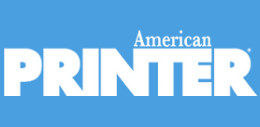
Have you seen Playboy's June issue, featuring “Miss Playmate of the Year” in 3D? Put on your special glasses and voila. Who says printing is old school technology?
“It's kind of like it says on the rearview mirror,” jokes Hope Dworaczyk, the subject of the photo spread. “Things may appear larger.”
Not everyone is excited about 3D in print. “This particular picture is one example of how books and magazines are different (than computer images),” the Associated Press quoted editor Hugh Hefner as saying. “You can hold it in your hands, save them, and as Dad used to, put them under the mattress.”
Lets hear it for the value of print!
“I'm not a huge enthusiast of 3D,” continued Hefner. “I leave real life to go to the movies and 2D is fine with me.”
I'm glad you brought that up, Hugh, because I wholeheartedly agree. Not just about the unique value of print, but also that print's future may very well lie more with 2D than with 3D.
2D barcodes are the generic name for an interesting glyph more commonly known as QR Codes, which is a trademarked name. The way they work is simple, simple enough to catch on easily with the general population.
The first step is downloading and installing reader software on a smartphone. The software is free and available from several sources on the Internet, dependent upon the brand of phone.
Once the software is installed, you may use the camera on your smartphone to take a picture of any 2D barcode you run across. The software recognizes the glyph as a 2D barcode, interprets it, and takes whatever action the barcode has been created for.
Right now the most common use of 2D barcodes is to take the user to a website. This means that after you photograph the barcode, your smartphone will open its web browser to display the URL specified by the barcode creator.
Much has been written about QR, or 2D barcodes. Almost too much. I'm already bored with reading about them. Bored yes, but only because most of what has been written so far has featured style over substance. “2D barcodes will be the salvation of print, blah, blah, blah.” We've been hearing this theoretical junk for decades.
First, digital printing was going to save print. It hasn't yet.
Next, variable data was going to save print. It hasn't yet.
Just recently, PURLs were going to save print. They haven't. I wrote a long treatise two years ago on this subject called “PURLs of wisdom” and “More PURLs before swine” in January and February 2008 (see http://americanprinter.com/johnsonsworld). Those old “Johnson's Worlds” are still right on target. You would do well to reread them, to help put this month's topic in context.
Recently, 2D barcodes are hailed by pundits desperate for something to write about as the newest salvation of print. There is one difference this time: Those pundits, in spite of themselves and without knowing why, might actually be right.
I've said many times that the digital revolution (which includes both the Internet and digital printing) is really an evolution. Digital printing enabled the use of variable data, which in turn allowed the creation of the personalized URL, or PURL.
A PURL allows sophisticated tracking and response, just as is possible with today's sophisticated email and web communications. The only thing the Internet has over print is clickability. One mouse click on a link is something people have accepted. People are much more reluctant to type a 40 character URL that must be typed and entered perfectly to work.
2D barcodes bring oneclick functionality to print. One click, that is, of the “shutter” on your prospect's smartphone. Fact is, that printed QR Code leapfrogs over Internet hyperlinks, because it works anywhere, anytime. All you need is to have your smartphone with you, which today's target audience does.
A 2D code works from a direct mail letter, to be sure, but it also works on a sign, within a catalog or emblazoned on an article of clothing.
Old fashioned? Don't carry a blackberry? You can read a QR Code with the camera built into your desktop or laptop PC, the same camera you use for conference calls and video recordings.
2D barcodes are a natural to combine with PURLs, but they also can direct people to a static website or be used to populate an online shopping cart. They can even dial a phone number.
Start by reading all the “introductory” articles to learn the basics of 2D. Next, stop and think.
How can you use these barcodes to make your customers' print clickable?